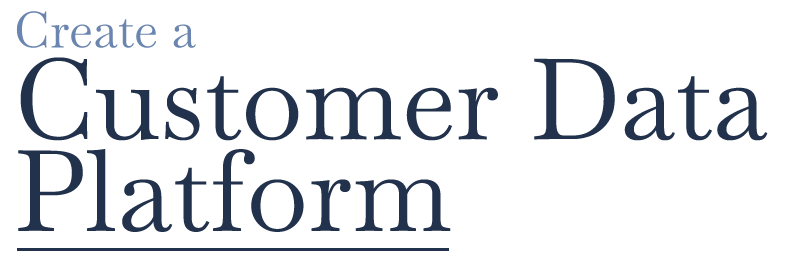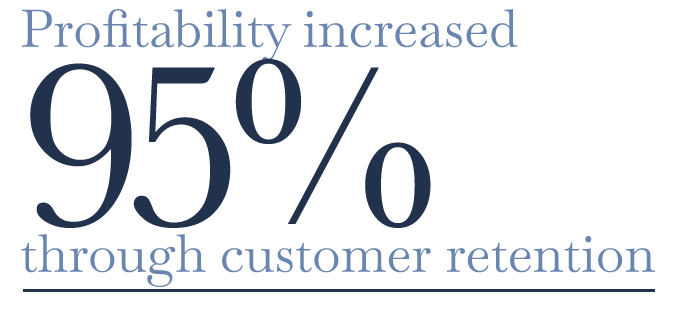6 Keys for Marketing Success in 2023
9 Min. Read

Marketing is constantly evolving, with new technologies, consumer behaviors, and market trends shaping how brands connect with their audiences. As we continue into 2023, it's clear that many key trends and developments will define the marketer's market. In this whitepaper, we will explore the most important trends, including the rise of artificial intelligence, the growing importance of personalization, and the changing role of data in marketing. We will provide a comprehensive overview of the marketer's market in 2023 and the opportunities and challenges that it presents.
1. Increasing Revenue and Growth
In 2023, companies must prioritize increasing revenue through marketing channels to stay competitive and drive growth, even with the potential for an economic recession looming. We will explore the most effective strategies and tactics to achieve this goal.
Ways this could be executed in 2023:
Alignment of Marketing & Sales
Aligning marketing and sales efforts is crucial for business leaders in marketing to improve lead generation and conversion rates to achieve common goals. Achieving alignment between sales and marketing can increase sales closing efficiency by 67%. This can be done by creating consistent messaging and branding, sharing leads and customer data, and regularly reviewing and adjusting the marketing plan to support sales objectives. Regular communication, collaboration, and shared goals and metrics are essential for alignment. Business leaders should establish regular meetings and check-ins between the teams to ensure everyone knows the company's overall goals and objectives.

Creating a Cohesive Sales Conversion Process
Marketing should focus on creating a seamless process for converting leads into paying customers by analyzing the lead generation and conversion process, optimizing lead nurturing campaigns, and implementing tools and technologies to increase conversion rates. Understanding the customer journey can help identify where leads are falling out and improve it through effective lead nurturing campaigns, marketing automation, and CRM tools.
Focusing on CLTV (Customer Lifetime Value)
Focus on maximizing the lifetime value of customers by retaining, and upselling to existing customers. This will drive sustainable growth and increase revenue over the long term by creating personalized customer experiences, providing excellent customer service, and leveraging data and analytics to identify upselling and cross-selling opportunities. Using data and analytics to understand customer needs and preferences and investing in customer service will help retain customers.
2. Personalization at Scale
Personalization at scale refers to delivering highly targeted, customized experiences to large numbers of customers through advanced technologies such as machine learning and artificial intelligence. It helps to drive engagement, increase conversions, and ultimately improve customer loyalty.
Let's take a deeper dive:
The Problem With Scaling Up
Scaling up personalization efforts can be challenging as it requires a significant investment in data, technology, and human resources. Companies need a solid data infrastructure, advanced algorithms, and machine learning models to handle large amounts of data and personalize experiences for thousands of customers. Even with automation in place, human staffing is still necessary to keep AI and ML models on track and optimized.
Bringing AI Into Customer Service
AI-enabled chat and customer service can be powerful tools for personalizing customer experiences at scale. Advanced natural language processing (NLP) and machine learning models can be used to understand customer queries and respond with personalized and relevant information. Additionally, AI-enabled chat and customer service can help automate routine tasks and allow human agents to focus on more complex interactions. This can help improve customer satisfaction, increase efficiency, and reduce customer service costs by up to 80%.

3. Marketing Tech
Marketing technology (MarTech) refers to the tools and software used to automate, optimize, and measure marketing efforts, such as marketing automation, CRM systems, analytics, social media management, and more. It helps companies to reach and engage with customers effectively by streamlining marketing processes.
What should you prioritize?
Is Your Stack Working As Well As It Could or Should?
Evaluating your marketing technology stack's effectiveness is essential in ensuring that your efforts produce the desired results. One way to determine if your stack is working as well as it should is to track key metrics such as engagement, conversion rates, and ROI. If you notice a decline in any of these metrics, it may indicate that your stack is not working as it should, and changes may be necessary.
How do you assess and make running changes? Evaluating and making running changes to your marketing technology stack can be done through continuous testing and experimentation. This includes A/B testing different elements of your campaigns, such as subject lines or call-to-action buttons, and analyzing the results to determine which variations are most effective. You can also conduct regular audits of your stack to identify and eliminate tools not delivering the desired results. By continuously monitoring and optimizing your marketing technology stack, you can ensure that it works as efficiently and effectively as possible.
Consider Customer Data Platform
A Customer Data Platform (CDP) is a marketing technology that allows businesses to collect, store, and manage customer data from multiple sources in a unified view. With a CDP, companies can create unique and persistent customer profiles, which can be used for targeted advertising, segmentation, and personalization. This enables companies to understand their customers better and create more personalized and effective marketing campaigns.

Incorporating Web3
Web3 is the next dimension of the internet that is being built on decentralized technologies. This new web will enable more secure and private data management, enabling new forms of e-commerce and customer engagement. Web3 technologies will also allow new forms of customer data management, enabling companies to build trust with customers and create more personalized experiences.
4. Data-Driven Strategy
A data-driven strategy for CMOs involves using data to inform and guide marketing decisions rather than relying solely on intuition or experience. This can include analyzing customer data to gain insights into target audiences, using performance data to optimize campaigns and measure success, and utilizing marketing automation and AI technologies to improve efficiency and effectiveness. Using data, CMOs can make more informed decisions, improve ROI, and better understand and engage with their target customers.
Here are two recommended ways to get started:
Find a Strategy to Collect First-Party Data in a Cookie-less World
A multi-pronged approach is needed for a more comprehensive data collection. CMOs can collect first-party data in a cookie-less world by using alternative tracking methods, engaging directly with customers, and gathering data from internal sources such as CRM, customer service, and e-commerce transactions. They should also encourage customers to share their data directly, and leverage owned media channels for data collection.
Gather Authentic Audience and Consumer Insights
CMOs need true audience/consumer insights, not just data collection, to make informed decisions about their marketing strategies. Accurate insights provide a deeper understanding of customers, identifying patterns and trends to inform marketing decisions, creating more effective campaigns, leading to improved ROI and increased customer loyalty.
5. How Much of Your Team Needs to be In-House?
Factors like cost-effectiveness, brand control, flexibility, knowledge retention, and data security should be considered when deciding how much to handle marketing in-house and how much to outsource it. In-house marketing can be cost-effective, ensure brand control, provide flexibility, retain knowledge, and ensure data security.
Here are a few other factors to consider:
Overall Company Size
No, the size of a company does not determine whether marketing should be done in-house or outsourced. Other factors such as budget, marketing goals, resources, and expertise should be considered when deciding whether to bring marketing in-house or hire an agency.
Industry Effect and Needs
The industry's effect can influence the decision to bring marketing in-house. B2B and B2C companies have different marketing needs and strategies, so that the choice may vary. Some industries may also have specific regulations or unique marketing requirements requiring in-house expertise. Ultimately, the decision to bring marketing in-house depends on company size, budget, marketing goals, and available resources.
Budgeting for Marketing
When creating a budget for in-house marketing, CMOs should consider various factors to ensure that their efforts are effectively funded. These factors include the resources required for in-house marketing, including personnel (such as in-house marketers, designers, and writers), tools and technology (such as CRM, analytics, and project management software), and content creation (such as videos, images, and blog posts).
They also consider the cost of running marketing campaigns (such as social media, email, and paid advertising) and the cost of training and development for in-house marketers (including conferences, courses, and certifications). Finally, overhead costs such as office space and utilities are also considered.
6. Performance and Brand Marketing are the Complete Recipe
Performance and brand marketing are crucial for a successful marketing strategy. Both working together create a balanced marketing approach. The performance focuses on mid funnel conversion of existing demand and is measurable in terms of actions, sales, and leads through tactics like paid search and affiliate marketing. The brand focuses on building awareness and the unique positioning in broader channels to drive campaigns that show unique selling propositions.
Not only are measurement and marketing attribution necessary, but so is the ability to test, measure, and pivot marketing strategies to maximize ROI.
As a CMO, it's crucial to have a data-driven marketing approach. Measuring and attributing the impact of marketing efforts helps to understand what's working and what's not, but this information is only helpful if it's acted upon. The ability to test, measure, and pivot marketing strategies allows CMOs to maximize return on investment (ROI) by continuously refining their approach based on results. This iterative process helps improve marketing effectiveness, increase ROI, and drive business growth.
Why Existing Customers Need Attention, Too
It’s easy to look at growth in terms of new customer acquisition. New customers, however, cannot be the only metric. No customer base is permanent, and acquiring a new customer is often more expensive than retaining an existing one. The common wisdom that a new customer is 500% more expensive to acquire, however, is no longer necessarily true. The answer to the question “Should we focus on retaining or acquiring customers?” must be in the form of both/and, not either/or.
By working with existing customers, companies can gain a deeper understanding of their needs, preferences, and behavior, which can inform future product development and marketing strategies. Return customers can push profitability, with a 5% increase in retention rate driving up profitability by 25%-95%.

Cross-selling, upselling, and renewals effectively focus on existing customers. Focusing on existing customers leads to higher lifetime value, lower acquisition costs, increased customer loyalty, and a better understanding of customer needs. This results in higher profitability and reduced churn.
In Conclusion
Executives must stay informed of the latest trends to ensure they are hiring the right CMOs for their companies. In 2023, the most important trends include artificial intelligence, personalization's increasing importance, and data's changing role in marketing. Marketing should maximize customer lifetime value by acquiring, retaining, and upselling to existing customers. Personalization at scale can be challenging but is crucial for driving engagement, increasing conversions, and improving customer loyalty. Evaluate your marketing technology stack's effectiveness, assess, and make running changes for optimal efficiency, and consider implementing a Customer Data Platform to understand customers better and create effective marketing campaigns.



